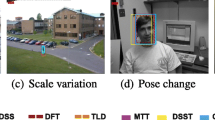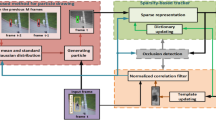Abstract
This paper proposes a patch-based tracking algorithm via a hybrid generative-discriminative appearance model. For establishing the generative appearance model, we present a spatio-temporal constraint-based sparse representation (STSR), which not only exploits the intrinsic relationship among the target candidates and the spatial layout of the patches inside each candidate, but also preserves the temporal similarity in consecutive frames. To construct the discriminative appearance model, we utilize the multiple-instance learning-based support vector machine (MIL&SVM), which is robust to occlusion and alleviates the drifting problem. According to the classification result, the occlusion state can be predicted, and it is further used in the templates updating, making the templates more efficient both for the generative and discriminative model. Finally, we incorporate the hybrid appearance model into a particle filter framework. Experimental results on six challenging sequences demonstrate that our tracker is robust in dealing with occlusion.
Access this chapter
Tax calculation will be finalised at checkout
Purchases are for personal use only
Similar content being viewed by others
References
Adam, A., Rivlin, E., Shimshoni, I.: Robust fragments-based tracking using the integral histogram. In: 2006 IEEE Computer Society Conference on Computer Vision and Pattern Recognition, vol. 1, pp. 798–805, IEEE (2006)
Babenko, B., Yang, M.H., Belongie, S.: Visual tracking with online multiple instance learning. In: IEEE Conference on Computer Vision and Pattern Recognition, CVPR 2009, pp. 983–990, IEEE (2009)
Jia, X., Lu, H., Yang, M.H.: Visual tracking via adaptive structural local sparse appearance model. In: 2012 IEEE Conference on Computer Vision and Pattern Recognition (CVPR), pp. 1822–1829, IEEE (2012)
Kalal, Z., Matas, J., Mikolajczyk, K.: PN learning: bootstrapping binary classifiers by structural constraints. In: 2010 IEEE Conference on Computer Vision and Pattern Recognition (CVPR), pp. 49–56, IEEE (2010)
Kwon, J., Lee, K.M.: Visual tracking decomposition. In: 2010 IEEE Conference on Computer Vision and Pattern Recognition (CVPR), pp. 1269–1276, IEEE (2010)
Li, X., He, Z., You, X., Chen, C.P.: A novel joint tracker based on occlusion detection. Knowl. Based Syst. 71, 409–418 (2014)
Yang, F., Lu, H., Yang, M.H.: Robust superpixel tracking. IEEE Trans. Image Process. 23(4), 1639–1651 (2014)
Yao, R., Shi, Q., Shen, C., Zhang, Y., van den Hengel, A.: Part-based visual tracking with online latent structural learning. In: 2013 IEEE Conference on Computer Vision and Pattern Recognition (CVPR), pp. 2363–2370, IEEE (2013)
Zarezade, A., Rabiee, H., Soltani-Farani, A., et al.: Patchwise joint sparse tracking with occlusion detection. IEEE Trans. Image Process. 23(10), 4496–4510 (2014)
Zhang, T., Liu, S., Xu, C., Yan, S., Ghanem, B., Ahuja, N., Yang, M.H.: Structural sparse tracking. In: Proceedings of the IEEE Conference on Computer Vision and Pattern Recognition, pp. 150–158 (2015)
Zhong, W., Yang, M., et al.: Robust object tracking via sparse collaborative appearance model. IEEE Trans. Image Process. 23(5), 2356–2368 (2014)
Acknowledgments
This work is supported by the National Natural Science Foundation of China (No. 61175096 and 61273273), Specialized Fund for Joint Building Program of Beijing municipal Education Commission.
Author information
Authors and Affiliations
Corresponding author
Editor information
Editors and Affiliations
Rights and permissions
Copyright information
© 2015 Springer International Publishing Switzerland
About this paper
Cite this paper
Wang, Y., Zhao, Q. (2015). Patchwise Tracking via Spatio-Temporal Constraint-Based Sparse Representation and Multiple-Instance Learning-Based SVM. In: Arik, S., Huang, T., Lai, W., Liu, Q. (eds) Neural Information Processing. ICONIP 2015. Lecture Notes in Computer Science(), vol 9489. Springer, Cham. https://doi.org/10.1007/978-3-319-26532-2_29
Download citation
DOI: https://doi.org/10.1007/978-3-319-26532-2_29
Published:
Publisher Name: Springer, Cham
Print ISBN: 978-3-319-26531-5
Online ISBN: 978-3-319-26532-2
eBook Packages: Computer ScienceComputer Science (R0)




